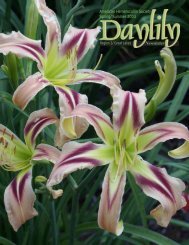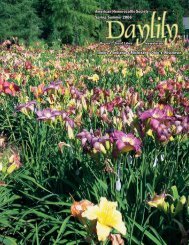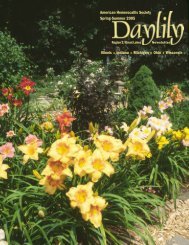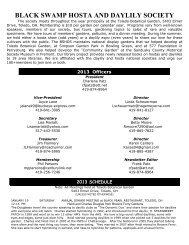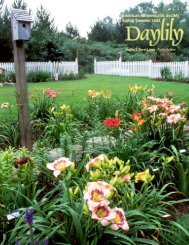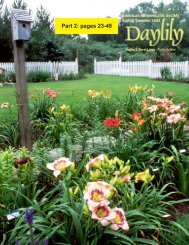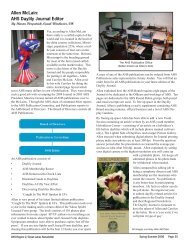Pages - AHS Region 2
Pages - AHS Region 2
Pages - AHS Region 2
Create successful ePaper yourself
Turn your PDF publications into a flip-book with our unique Google optimized e-Paper software.
The most exciting result of the F2 stage is plant vigor. They are robust and exhibit strong branching and good bud count, even by their<br />
first bloom year, which in this zone means the plant is in its second year of growth.<br />
As for form, H. fulva littorea appears to produce more spidery offspring than other fulva types, while H. ‘Hankow’ throws large plants<br />
and large, traditional blooms, the true, natural form of flowers of the species and early hybrids. In that sense, one could say that the fullform<br />
rounded types are actually the “unusual forms”. You can get round forms from fulva crosses as well, of course, depending on the<br />
parents used, as shown by one of the seedlings at the bottom of the previous page.<br />
Crossing H. fulva With Tetraploids: The Third Generation<br />
My third generation H. fulva crosses bloomed for the first time this summer (2005), and some examples from about 200 seedlings are<br />
shown here. The fulva portion of each cross has dropped to one-eighth. The best seedlings all come from one particular cross, H. fulva<br />
‘Hankow’ X H. ‘Ruby Spider’, with various other partners. The plants are very robust, with great branching for first year bloom. Form<br />
and color are not spectacular, but quite complex. The miniature (3.75" flower) seems to be a genetic anomaly in a cross usually producing<br />
large flowers. The results in general show that crossing diploid fulvas with tetraploids can be done and that the results warrant further<br />
exploration. This seems to be one way of achieving increased genetic diversity.<br />
Left:<br />
H. ‘Christmas<br />
Tidings’ X [(H.<br />
fulva ‘Hankow’ x<br />
H. ‘Ruby<br />
Spider’) x H.<br />
‘Star of India’]<br />
(36 6)<br />
Right: [H. ‘Godzilla’<br />
x ( H. fulva ‘Hankow’<br />
x H. ‘Ruby Spider’)]<br />
X H. ‘Brooklyn<br />
Twist’ (38 7)<br />
Left:<br />
[H. ‘Red Suspenders’<br />
x (H. fulva ‘Hankow’<br />
x H. ‘Ruby Spider’)]<br />
X H. ‘Royal<br />
Celebration’ (40 9)<br />
Left:<br />
[(H. fulva<br />
‘Hankow’ x H.<br />
‘Ruby Spider’) x<br />
H. ‘Star of<br />
India’] X H.<br />
‘Web Brower’<br />
(38 9)<br />
Left:<br />
[(H. fulva ‘Hankow’ x<br />
H. ‘Ruby Spider’) X H.<br />
‘Star of India’] X H.<br />
‘Skinny Dipping’ (36 8)<br />
Right:<br />
[H. ‘Godzilla’ x (H.<br />
fulva ‘Hankow’ x H.<br />
‘Ruby Spider’)] X<br />
H. ‘Bali Watercolor’<br />
(15 3.75)<br />
Where do I go from here I have been making crosses between various H. fulva varieties and some of the most recent tetraploid<br />
introductions such as H. ‘Velvet Ribbons’, H. ‘Orchid Waterfall’, H. ‘Freewheeling’ and H. ‘Spinnaker’. Also, I’ve begun back crossing,<br />
line breeding, in order to explore the hidden genotypes behind the phenotypes (the physical appearance) I’ve illustrated. I welcome<br />
visitors to our garden to help in the future process of evaluation.<br />
In my professional life I try to make a distinction between what is<br />
merely a novelty and what is actually new (which is a relatively rare<br />
thing). I think it is too early to say whether my experimenting with<br />
the use of diploid fulvas in tetraploid breeding is just a novelty, or<br />
really something new.<br />
Editor’s Note: Gil Stelter spoke at the 2005 <strong>Region</strong> Symposium in<br />
Cleveland, Ohio. He presented a Microsoft PowerPoint slide show<br />
to illustrate his topic, Incorporating Species in Northern Hybridizing.<br />
Here, by popular request, he brings the details of his<br />
hybridizing program.<br />
All images, unless otherwise specifically indicated, were provided<br />
by Author Gil Stelter, 7 Orchard Crescent, Guelph, Ontario,<br />
Canada N1E 1W9 (gstelter@uoguelph.ca ). Interested in daylily<br />
species Why not visit http://members.tripod.com/daylily6/<br />
Species/Species.htm<br />
<strong>AHS</strong> <strong>Region</strong> 2/Great Lakes Newsletter<br />
Fall 2005 - Winter 2006 Page 17



